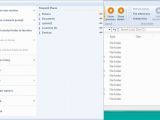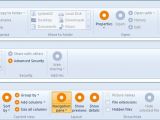The latest leaked screenshots from an early development milestone of Windows 8 appear to reveal the fact that Microsoft is working to connect the next major iteration of the Windows client to the Cloud like never before. Windows Live and Windows have always been marketed as somewhat of a package deal by the software giant, but no amount of marketing made the two feel like functioning in unison instead of a sum of disparate solutions.
In some of my past articles, I asked for a deeper integration of Microsoft’s services and Cloud applications into Windows 8, and it appears that the Redmond company will, at least in part, make my wishes come true.
Windows vNext will ship with an overhauled Windows Explorer, sporting the Ribbon / Fluent UI instead of the traditional File menu and toolbar.
The screenshots offered by Rafael Rivera and Paul Thurrott allow users not only to feast their eyes on the upcoming Windows Explorer UI, but also to get a sneak peek at some next generation capabilities in Windows 8.
Web sharing and synchronization will be default options in Windows Explorer for customers running Windows 8. Yes, right in Windows 8.
There’s no telling how this will happen exactly, although it’s not that hard to guess. With Windows Live Essentials Microsoft provides customers with Windows Live Mesh, the successor of Live Mesh Beta and Windows Live Sync.
Windows Live Mesh is designed to help users keep devices it’s running on in sync. Up to 5GB of content can be synchronized per each Windows Live account.
Right now there are a few shortcomings to Mesh that hopefully will be fixed in Windows Live Essentials vNext.
Users should be able to get information on the progress of files synchronizing, including visual feedback on what files are synched, data transfer, etc. At the same time Windows Explorer and Mesh integration is a must, let’s just hope that Microsoft gets it right.
And performance, let’s not forget performance. Windows Live Mesh feels a bit slow, maybe also because of the fact that there are no cues when the sync process will complete.
Speed is also of the essence when it comes to web sharing, which I suspect will happen through Windows Live SkyDrive.
Files need to be uploaded to SkyDrive before they’re shared across the Internet, and this should happen as fast as possible.
At the same time, the Cloud-based part of Mesh and SkyDrive need to be better connected to one another, essentially to the point where users cannot tell the difference between the two. And let’s not forget the fact that SkyDrive should allow customers to share not just folders but also individual files.

 14 DAY TRIAL //
14 DAY TRIAL // 

